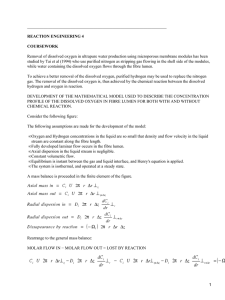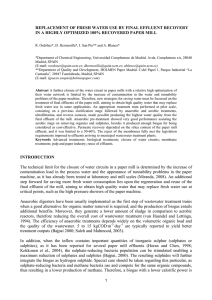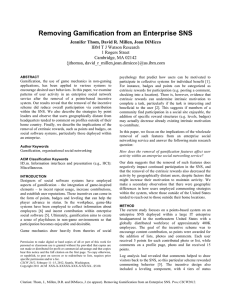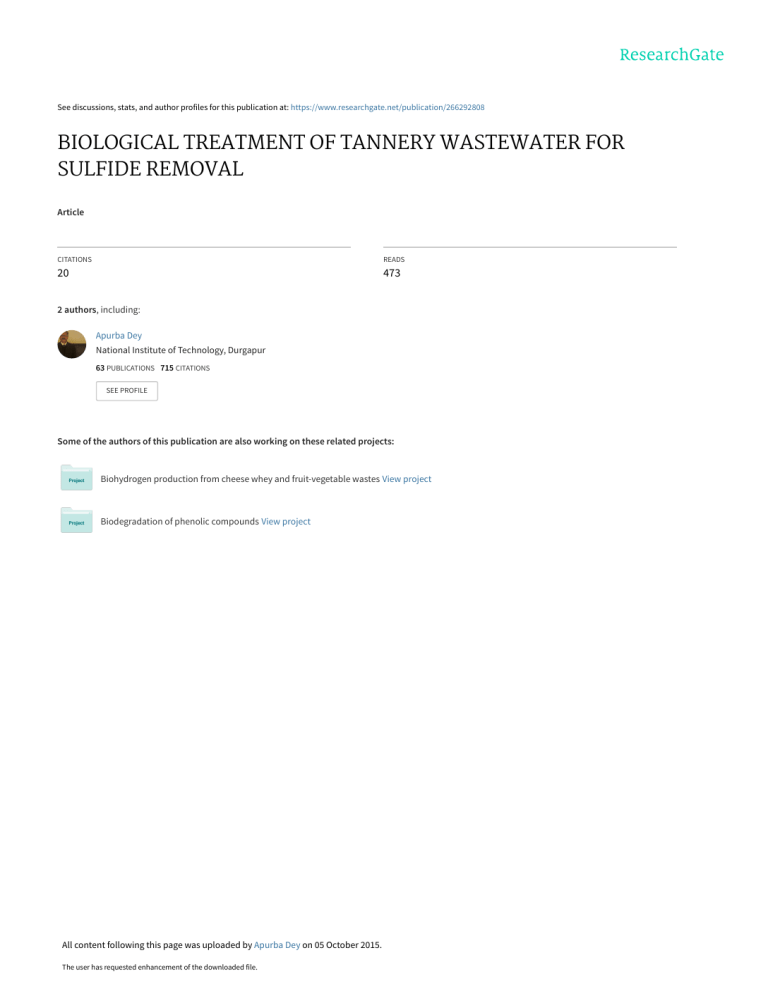
See discussions, stats, and author profiles for this publication at: https://www.researchgate.net/publication/266292808 BIOLOGICAL TREATMENT OF TANNERY WASTEWATER FOR SULFIDE REMOVAL Article CITATIONS READS 20 473 2 authors, including: Apurba Dey National Institute of Technology, Durgapur 63 PUBLICATIONS 715 CITATIONS SEE PROFILE Some of the authors of this publication are also working on these related projects: Biohydrogen production from cheese whey and fruit-vegetable wastes View project Biodegradation of phenolic compounds View project All content following this page was uploaded by Apurba Dey on 05 October 2015. The user has requested enhancement of the downloaded file. Int. J. Chem. Sci.: 6(2), 2008, 472-486 – A REVIEW BIOLOGICAL TREATMENT OF TANNERY WASTEWATER FOR SULFIDE REMOVAL VARSHA MIDHA∗ and APURBA DEY Department of Chemical and Bio Engineering, National Institute of Technology, JALANDHAR - 144 011 (Punjab) INDIA ABSTRACT The transformation of hides into leather is usually done by using tanning agents and a highly turbid, colored and foul smelling wastewater is generated in the process. The major components of the effluent include sulfide, chromium, volatile organic compounds, large quantities of solid waste, suspended solids like animal hair and trimmings. The various components present in the effluent affect human beings, agriculture and livestock besides causing severe ailments to the tannery workers. The environmental protection regulations stipulate that industries are not allowed to emit sulfide and chromium in the wastewater. Thus removal of sulfide and chromium from the wastewater is very important. A number of researchers worked on the removal of sulfide and chromium from the wastewater streams, but little has been reported on the sulfide removal from the tannery wastewater. In this paper, characteristics of tannery wastewater and methods of sulfide removal have been discussed. Key words: Aerobic, Anaerobic, Sulfide, Chromium, Fatliquoring, Tanning INTRODUCTION Tanning is the chemical process that converts animal hides and skin into leather and related products. The transformation of hides into leather is usually done by means of tanning agents and the process generates highly turbid, colored and foul smelling wastewater. The major components of the effluent include sulfide, chromium, volatile organic compounds, large quantities of solid waste, suspended solids like animal hair and trimmings1. For every kilogram of hides processed, 30 liters of effluent is generated and the total quantity of effluent discharged by Indian industries is about 50,000 m3 /day. The various components present in the effluent affect human beings, agriculture and livestock besides causing severe ailments to the tannery workers such as eye diseases, skin ∗ Author for correspondence 473 Int. J. Chem. Sci.: 6(2), 2008 irritations, kidney failure and gastrointestinal problems. Tannery waste material also varies considerably in volume and concentration due to continuous operation and intermittent discharge. The composition of tannery wastewater has been shown in Table 12. Sulfide is one of the major components of the tannery effluent. It causes an irritating, rotten-egg smell above 1 ppm (1.4 mg m−3), and at concentrations above 10 ppm, the toxicological exposure limits are exceeded3. It is highly toxic to human beings. It can cause headaches, nausea and affect central nervous system even at low levels of exposure. It causes death within 30 min at concentrations of only 800–1000 mg/L, and instant death at higher concentrations4. The upper concentration5 limit of sulfide in water intended for human consumption is 250 mg/L. The corrosive properties of sulfide are apparent in the damage done to concrete walls of reactors, sewer systems and steel pipelines. It also inhibits the methanogenesis process6. Soluble sulfide ranging from 50 – 100 mg/L can be tolerated in anaerobic treatment with little or no acclimation7. Sulfide has high oxygen demand of 2 mols O2/mol sulfide and causes depletion of oxygen in water8. Table 1. Composition of tannery wastewater2 Mean composition of tannery waste liquors BOD (mg/L) 210 - 4300 COD (mg/L) 180 - 27000 Total suspended solids (mg/L) 925 - 36000 Total chromium (mg/L) 3 - 350 Sulfides (mg/L) 1 - 500 Chlorides (mg/L) 1500 - 28000 Total phenolic compounds (mg/L) 0.4 - 100 Ammonium nitrogen (mg/L) 17 - 380 Kjehdahl nitrogen (mg/L) 90 - 630 Fats and oils (mg/L) 49 - 620 pH 1 - 13 474 V. Midha and A. Dey: Biological Treatment of…. Chromium salts used during the tanning process generate two forms of chrome; hexavalent chromium and trivalent chromium. Hexavalent chromium is highly toxic to living organisms even at low concentration causing carcinogenic effect9. Trivalent chromium may be present in the waste or can be produced from the hexavalent chromium by chemical treatment. Soluble trivalent chromium causes toxicity in anaerobic digestion due to the accumulation of the metal in the intracellular fraction of biomass10. Several components in the effluent contain nitrogen as part of their chemical structure, which can lead to development of anaerobic conditions harmful to the aquatic life. The environmental protection regulations stipulate that industries are not allowed to emit sulfide and chromium in the wastewater. Thus, removal of sulfide and chromium from the wastewater is very important. A number of researchers worked on the removal of sulfide and chromium from the wastewater streams, but little has been reported on the sulfide removal from the tannery wastewater11-16. The objective of this paper is to review the treatment of tannery wastewater and methods of sulfide removal. Manufacturing of leather The manufacturing of leather can be divided into two parts (Fig. 1); beam house operations and tanning process. In beam house operations, the removal of dirt and blood by washing is the first step after which the hides are then soaked in water for softening and removal of salts. After the removal of salts, fatty tissue is removed by fleshing. Liming is done to swell the hides for the better penetration of tanning agents and hair removal. Chemical dissolution of the hair and epidermis with an alkaline medium of sulfide and lime takes place. During liming, a high concentration of sodium sulfide, lime and organic matter is delivered to the effluent. Hides are then neutralized with acid ammonium salts and treated with enzymes to remove the hair remnants and to degrade proteins. This results in a major part of the ammonium load in the effluent. Pickling is usually done to prepare the hides for tanning. The pH value of hides is adjusted by addition of acids (mainly sulfuric acid). Salts are added to prevent the hides from swelling. Tanning is the reaction of the collagen fibers in the hides with tannins, chromium, alum or other chemical agents. Alums, syntans, formaldehyde, glutaraldehyde and heavy oils are used as tanning agents. During the tanning process, about 300 kg chemicals are added per ton of hides. Based on the tanning agents, tanning operations are further divided into vegetable tanning and chrome tanning. Vegetable tanning is usually done in series of vats by using natural organic substances. 475 Int. J. Chem. Sci.: 6(2), 2008 Salts Storing of hides/preservation Water, BOD, COD Trimming Alkali, Enzymes, Surfactants Washing and Soaking Water, Salt, BOD, COD Fleshing Sodium sulfide H2S gas, Hairs, Lime, BOD, COD, Ammonia, Unhairing/liming Ammonium sulfate, Acid, Enzymes Ammonia, BOD, COD Bating Pickling Sodium chloride, Acids Chromium salts/vegetable tannin gagents Fleshy particles, Fats BOD, COD, Suspended solids, salts Chromium/vegetable tans Tanning: Vegetable/Chrome Splitting Chrome splits Wringing Shaving Retanning Dyes Fat liquor Dyeing Fatliquering BOD, COD, dyes Fats Drying Conditioning Buffing Solvents, pigments, dyes Finishing and plating Buffing dust Solvent vapours, solid or liquid finisher residues Finished leather Fig. 1: Manufacturing of leather 476 V. Midha and A. Dey: Biological Treatment of…. Chrome tanning is done at a higher pH using chromium salts. After tanning, tanned leather is piled down, wrung and graded for thickness and quality, split into flesh and grain layers and shaved to desired thickness. In chrome tanning, retanning, dyeing and fatliquoring are the additional steps as compared to the vegetable tanning. Fatliquoring is the process of introducing oil into the skin before the leather is dried to replace the natural oils lost in beam house and tan yard processes. After drying, a number of finishing operations like buffing, plating and embossing are carried out to make the leather softer and aesthetic. Wastewater treatment Various physiochemical techniques used for wastewater treatment can be applied to tannery wastewater (to the entire process or to individual step in the process) but these processes are expensive. Biological treatment of wastewater is more favorable and cost effective as compared to other physiochemical methods. Various microorganisms are capable of reducing the content of pollutants significantly by utilizing them as energy and nutrient source in the presence or absence of oxygen17. Aerobic treatment Aerobic microorganisms use organic carbon in the effluent and convert it to biomass and carbon dioxide. A large amount of sludge is generated along with high energy consumption in the process. Aerobic treatment of tannery wastewater reduces chemical oxygen demand (COD) by 60-80% and biological oxygen demand (BOD) reduction is 95%, when combined with physicochemical pretreatment18. In a combined biochemical oxidation and chemical ozonation step, chemical oxygen demand (COD), total Kheldal nitrogen (TKN) and total suspended solids (TSS) removals of 96%, 92% and 98%, respectively were obtained. Ozonation step was integrated with sequencing batch biofilm reactor. Ozonation partially oxidizes the refractory compounds present in tannery wastewater and increases their biodegrability. Sludge production was 0.1 kg VSS/ kg COD removed, which is lower than the value reported in the literature for conventional biological systems. Aerobic treatment followed by chemical ozonation and again aerobic treatment further increases the biodegrability of refractory compounds19. 477 Int. J. Chem. Sci.: 6(2), 2008 A combination of electrochemical and biological treatment can also be used to eliminate ammonia and avoid implementation of biological nitrification20. Respirometry combined with sequencing batch reactor is an effective method for the removal of COD in tannery effluent. At 12 h sequencing batch reactor cycle with a loading rate of 1.9-2.1 kg/m3 day, removals of COD, TKN and NH3-N were 80-82%, 7880% and 83-99%, respectively. The removal efficiencies were much higher than conventional aerobic systems21. Anaerobic treatment Anaerobic treatment of wastewater converts the organic pollutants into a small amount of sludge and large amount of biogas (methane and carbon dioxide). The sulfide present in wastewater inhibits the anaerobic treatment. Table 2 shows the effect of sulfide formation in anaerobic reactors22. Methanogenic bacteria are inhibited by sulfide, whereas acidifying and sulfate reducing bacteria do not inhibit. Three inhibiting effects of sulfide or sulfide reduction are known: direct toxicity of sulfide, substrate competition between sulfate reducing and methanogenic bacteria and precipitation of trace elements by sulfide. The extent of these effects depends on the experimental system used. In a continuous fixed film reactor23, the efficiency of degradation was improved by 15% at a hydraulic retention time of 1.9 days when the concentration of undissociated sulfide was reduced from 100 to 30 mg/L. Table 2. Effect of sulfide formation in anaerobic reactors Disadvantages Advantages Reduced COD removal efficiency Removal of sulfate, sulfite and thiosulfate from the waste stream Corrosion Heavy metal removal Accumulation of inert material in the sludge (e.g. metal sulfides) Precipitated metal sulfides Less methane formation Cont… 478 V. Midha and A. Dey: Biological Treatment of…. Disadvantages Advantages Poor biogas quality + need for H2S removal from the biogas Malodor Potential toxicity Disturb the aerobic activated sludge post treatment system (activated sludge bulking; excessive growth of phototrophs) In two stage anaerobic treatment of tannery wastewater, 30% of the sulfate was reduced independent of the sulfate influent concentration in the first stage. With high concentration of sulfate in influent, percentage of desulfurization decreased in the second stage24. Pretreatment of wastewater for reducing the tannin, chromium and sulfide levels gives better results in COD removal efficiency. In anaerobic up flow contact filter, COD removal efficiency was in the range of 79-95% after pretreatment compared to 60-86% for untreated wastewater. The biogas production was in the range of 95-198 mL/hr after pretreatment compared to 98-200 mL/hr for untreated wastewater. In batch process, 60 mg/L of sulfide, 60 mg/l chromium and 400 mg/L of tannin inhibited microbial growth whereas in continuous process, toxicity occurs at higher range25. In up flow fixed biofilm reactor, 60-75% COD removal and 0.36 m3/kg COD removed methane yield has been obtained. It has been found that porous polyurethane foam material is more suitable than Raschig rings as a micro carrier in fixed film reactor26. Sulfur recovery unit integrated with UASB up flow anaerobic sludge blanket reactor for the treatment of tannery wastewater resulted in stripper efficiency of 65 to 95% in terms of sulfide removal. Sulfur recovery unit consisted of a stripper column, absorber column, regeneration unit and sulfur separator27. Up flow anaerobic sludge blanket reactor with activated sludge reactor without recirculation of the sludge gave 96% COD removal at 8 days of hydraulic retention time and 71 g/L of total dissolved solids 28. 479 Int. J. Chem. Sci.: 6(2), 2008 In up flow anaerobic sludge blanket reactor, average COD removal efficiency is 65% at organic loading rate in the range of 0.2 - 7 kg/m3d. The average gas production is 0.3 m3/kg of COD removed29. A combined aerobic and anaerobic treatment of tannery with 900 mg/L dissolved organic carbon corresponding to discharge of 23 kg/ton of raw hides gave 85% removal efficiency of the dissolved organic carbon30. Sulfide removal methods Use of sodium sulfide and sodium hydrosulfide in tannery for dehairing the hides result in the sulfide content varying from 10 - 5000 mg/L. Sulfate generated during the process also gets converted into sulfide during anaerobic treatment. In the absence of dissolved oxygen and nitrate, sulfate reducing bacteria converts sulfate into sulfide In order to remove sulfide from wastewater streams, a number of physicochemical methods like direct air stripping, chemical precipitation and oxidation are in common use today. Many of the metals such as iron, zinc, copper etc. can be used to precipitate the sulfide into insoluble metal sulfide. Oxidation processes used for sulfide removal are aeration (catalyzed and uncatalyzed), chlorination, ozonation, potassium permanganate treatment and hydrogen peroxide treatment. During the sulfide oxidation by aeration, there is some loss of sulfide directly in the atmosphere. Sulfide consumes the oxygen in the aerator and reduces the effectiveness of the equipment. In chlorination, chlorine reacts with certain metals and organic matter in the water to form hazardous chlorinated organic chemicals. Catalytic chemical oxidation of the sulfide with air removes the sulfide quantitatively but it is a time consuming and expensive process. Following reaction takes place, when potassium permanganate reacts with hydrogen sulfide – 3 H2S + 4 KMnO4 → 2 K2SO4 + S + 3 MnO + MnO2 + 3 H2O Hydrogen peroxide oxidizes the hydrogen sulfide to elemental sulfur via following reaction: 8 H2S + 8 H2O2 → S8 + 16 H2O In all these processes, apart from elemental sulfur, sulfate and thiosulfate are generated, which are difficult to separate. For the removal of hydrogen sulfide from the gas streams, various methods are reported in the literature. In commercially used Claus process, hydrogen sulfide is oxidized 480 V. Midha and A. Dey: Biological Treatment of…. with air to produce sulfur dioxide. The mixture of H2S/SO2 is then passed over bauxite catalyst to yield elemental sulfur and water. The relatively high energy requirements or the high chemical and disposal costs besides environmental problems constitute important drawbacks of these methods. Therefore, alternative techniques for the hydrogen sulfide removal are required. Partial biological oxidation of sulfide to sulfur is a cheap alternative, which also allows sulfur reclamation, since sulfur is non-soluble and thus, it can be removed from the wastewater31,32. The partial oxidation of H2S to elemental sulfur instead of sulfate has several advantages. Elemental sulfur is a non-toxic, non-corrosive solid containing more sulfur per unit mass (3-8 times more valuable than H2SO4)33. Moreover, the elemental sulfur generated during the process can be used as a feedstock for the chemical, fertilizer and materials manufacturing industries. Several microorganisms have been studied for application in biotechnological hydrogen sulfide removal processes. The following (biological) overall reaction occurs in an aerobic sulfide removal system34; 2 HS− + O2 2 Sº + 2 OH− 2 Sº + 3 O2 2 SO42− + 2 OH+ Aerobic microorganisms or chemotrophes used for the oxidation of hydrogen sulfide are the species of Thiobacillus, Pseudomonas, Beggiatoa and Thiothrix which have been thoroughly studied by various researchers. These microorganisms use inorganic carbon as a carbon source and chemical energy from the oxidation of reduced inorganic compounds. The simpler nutritional requirements and higher sulfide tolerance of chemotrophic organisms favored their application in biological sulfide oxidation35. Various Thiobacillus species are widely used in conversion of hydrogen sulfide to sulfur on the laboratory scale i e. T. thiooxidans and T. ferroxidans grow at low pH 1-6 while T. denitrificans, T. thioparus and T. novellas can grow at pH 6-8. Studies using chemotrophes for sulfide removal have been summarized in Table 336-39. Sublette and Sylvester40 focused on the use of Thiobacillus denitrificans for the oxidation of sulfide to sulfate40. Buisman et al31. used a mixed culture of Thiobacilli for the aerobic oxidation of sulfide to elemental sulfur. Oh et al38. 1998 used three phase fluidized bed bioreactor with Thiobacillus sp. IW immobilized on activated carbon and showed 94% hydrogen sulfide removal efficiency in the concentration range of 100-200 ppm with flow rate of 1-2 liter/m. 481 Int. J. Chem. Sci.: 6(2), 2008 Table 3. Hydrogen sulfide removal using chemotrophs Influent (H2S) Sulfide loading rate(mg/l h) Sulfide removal efficiency (%) 1.44 2.0 0.27-0.32 mM in gas 38-51 32-33 100 100 FF, CSTR FF, Biorotor FF, U 8.3 3.0 20.0 35-174 mg/l 45-203 mg/l 45-225 mg/l 104-521 208-938 208-1040 60-100 69-100 73-100 Lizama and Sankey (1993) FF 0.34 0.17 mM in gas 19-38 69-73 Oh et al. (1998) Three phase FBR - 50-300 - 94 Krishnakumar et al. (2005) Reverse fluidized loop reactor 0.48 240 mg/l in gas 7.5-30 kg/m3 d 90-100 Volume of reactor (liter) Sublette (1987) CSTR Buisman et al. (1990b) Reference Configuration FF = Fixed film, CSTR = Continuous stirred tank reactor, U = Up flow, Plug = Plug flow reactor A biofilter system41 immobilized with Thiobacillus species showed a 95% removal efficiency of hydrogen sulfide at a gas flow rate up to 93 liter/h with an inlet concentration of 60 ppm, but efficiency was reduced to 78% for a gas flow rate of 180 liter/h. Visser et al42. found Thiobacillus sp.W5 as a dominant organism in the process42. Krishnakumar et al39. 2005 showed nearly 100% removal efficiency of hydrogen sulfide with sulfide loading rate up to 19 kg/m3d in a reverse fluidized loop reactor inoculated with T. denitrificans. The efficiency declined to 90% with accumulation of 15-18% thiosulfate for sulfide loading rate of 30 kg /m3d. Anaerobic microorganisms or phototrophs such as Chlorobium and Chromatium can be used for the conversion of hydrogen sulfide into sulfur. Phototrophs use carbon dioxide as a carbon source and light as an energy source. A number of studies using phototrophs for sulfide removal are shown in Table 48,43-51. 482 V. Midha and A. Dey: Biological Treatment of…. Table 4. Hydrogen sulfide removal using phototrophs Reference Configuration Volume of reactor (liter) Influent (H2S) Sulfide loading rate (mg/l h) Sulfide removal efficiency (%) Kobayashi et al. (1983) FF, U FF, plug 8 0.1 16 mg/L 19-24 mg/L 0.59-1.27 102-125 81-92 100 Cork et al. (1985) CSTR 0.8 - 74-109 100 Maka and Cork (1990) CSTR 0.8 1-2 mM in gas 32-64 90-100 Kim et al. (1991) CSTR 4 2.1 mM in gas 61 99.5 Kim et al. (1996) CSTR 11.9 1.45-1.87 mM in gas 14.6-19 99.8 Basu et al. (1996) CSTR 1.25 25000 ppm in gas 94.4 >96.6 Henshaw et al. (1997) CSTR 13.7 90-550 mg/L in liquid 2.1-5.6 >90 Henshaw et al. (1998) CSTR 13.7 20-30 mg/L in gas 2.1-5.6 100 Henshaw and Zhu (2001) FF 0.02 141-380 mg/L in liquid 111-286 82-100 Syed and Henshaw (2003) FF 0.0048 91-164 mg/L in liquid 1323-1451 100 FF = Fixed film, CSTR = Continuous stirred tank reactor, U = Up flow, Plug = Plug flow reactor Cork et al.43 introduced the concept of the van Niel curve in which light radiated to the photoreactor was plotted against sulfide loading rate. When the light intensity and sulfide loading rate were balanced on a point, all the sulfide was converted to the sulfur. 483 Int. J. Chem. Sci.: 6(2), 2008 The over all van Niel reaction is: 2n H2S + n CO2 2n Sº + (CH2O)n + n H2 O In a fixed film reactor50, up to 95% sulfur recovery was obtained with sulfide loading rate of 111-286 mg/h l while in continuous stirred tank reactor, 99.2% sulfur recovery was obtained with 94.4 mg/h l sulfide loading rate47. With sulfide loading rate of 1323 -1451 mg/h l and influent concentration of 91-164 mg/l in liquid, 100% sulfide removal efficiency was obtained51. Borkenstein and Fischer52 obtained 98.7% sulfide removal efficiency with 60.4% sulfur recovery by using purple sulfur bacteria Allchromatium vinosum strain 21 D. Major disadvantages in using photosynthetic bacteria on a large scale lie in their anaerobic nature and their requirement for strong light source. Also, phototrophic bacteria generally store the produced sulfur internally, making a separation of cells and sulfur impossible. Kleinjan et al.53 suggested that only those microorganisms should be used for the sulfide removal that can store sulfur extracellularly for easy separation of sulfur53. CONCLUSION Tannery wastewater is difficult to treat because of complex characteristics like high BOD, COD, suspended solids, sulfide and chromium. The main source of sulfide in tannery effluent is beam house operations. Anaerobic treatment of tannery wastewater gives better results but formation of sulfide in anaerobic reactors restricts its application. Various phototrophes and chemotrophes have been used for sulfide removal but requirement of light source is the major problem in case of phototrophes. Chemotrophes require careful control of oxygen to produce sulfur instead of sulfate but still some sulfate formation is there. REFERENCES 1. I. S. Thakur, “Environmental Biotechnology”, I. K. International Pvt. Ltd., New Delhi (2006) p. 398. 2. G. Vlyssides and C. J. Israilides, Environ. Poll., 97, 147 (1997). 3. WHO, Environmental Health Criteria 19, Geneva (1981) 4. R. E. Speece, Anaerobic Biotechnology for Industrial Wastewaters, Tennessee, Archae Press, (1996). 484 V. Midha and A. Dey: Biological Treatment of…. 5. N. Sawyer, P. L. McCarty and G. F. Parkin, Chemistry for Environmental Engineering and Science, McGraw-Hill, (2003). 6. G. K. Anderson, T. Donnelly and K. J. McKeown, Process Biochemistry, 17, 28 (1982). 7. R. E. Speece and G. F. parkin, Proc., 3rd Int. Symposium on Anaerobic Digestion, Boston (1983) p.23. 8. A. Kobayashi, M. Stenstrom and R. A. Mah, Water Research, 17(5), 579 (1983). 9. C. K. Lee, K. S. Low and K. L. Kek, Bioresource Technol., 54, 183 (1995). 10. U. Alkan, G. K. Anderson and O. Ince, Water Research, 30(3), 731 (1996). 11. S. Srivastava, A. H. Ahmad and I. S. Thakur, Bioresource Technol., 98, 1128 (2007). 12. N. F. Fahim, B. N. Barsoum, A. E. Eid and M. S. Khalil, J. Hazard. Mater. B, 136, 303 (2006). 13. I. Tadesse, S. A. Isoaho, F. B. Green and J. A. Puhakka, Bioresource Technol., 97, 529 (2006). 14. Y. S. Wang, Z. Y. Pan, J. M. Lang, J. M. Xu and Y. G. Zheng, J. Hazard. Mater., 147, 319 (2007). 15. E. Y. Lee, N. Y. Lee, K. S. Cho and H. W. Ryu, J. Bioscience and Bioengineering, 101(4), 309 (2006). 16. A. J. H. Janssen, G. Lettinga and A. de Keizer, Colloids and Surfaces A, Physico-Chem. and Engg. Aspects, 151, 389 (1999). 17. M. Eddy, Wastewater Engineering, Treatment Disposal and Reuse, McGraw Hill, (2003). 18. C. A. Sastry, Ind. J. Environ. Protect., 6, 159 (1986). 19. C. D. Iaconi, A. Lopez, R. Ramadori and R. Passino, Environ. Sci. Technol., 37, 3199 (2003). 20. L. Szpyrkowicz, S. N. Kaul and R. N. Neti, J. Applied Electrochem., 35, 381 (2005). 21. R. Ganesh, G. Balaji and R. A. Ramanujam, Bioresource Technol., 97, 1815 (2006). 22. L. W. Hulshoff Pol, P. N. L. Lens, A. J. M. Stams and G. Lettinga, Biodegradation, 9, 213 (1998) 23. M. Wiemann, H. Schenk and W. Hegemann, Water Research, 32(3), 774 (1998). 24. E. Genshow, W. Hegemann and C. Maschke, Water Research, 30(9), 2072 (1996). 25. K. Vijayaraghavan and D. V. S. Murthy, Bioprocess Engineering, 16, 151 (1997). Int. J. Chem. Sci.: 6(2), 2008 485 26. Z. Song, C. J. Williams and R. G. J. Edyvean, Environ. Engg. Sci., 20(6), 587 (2003). 27. R. Suthanthararajan, K. Chitra, E. Ravindranath, B. Umamaheswari, S. Rajamani and T. Ramesh, J. Am. Leather Chem. Assoc., 99(2), 67 (2004). 28. O. Lefebvre, N. Vasudevan, M. Torrijos, K. Thanasekaran and R. Moletta, Water Research, 40, 1492 (2006). 29. R. Suthanthararajan, E. Ravindranath, T. Ramesh, K. Chitra, B. Umamaheswari and S. Rajamani, J. Am. Leather Chem. Assoc., 101(1), 18 (2006). 30. T. Reemtsma and M. Jekel, Water Research, 31(5), 1035 (1997). 31. C. J. Buisman, B. Wit and G. Lettinga, Water Research, 24(2), 245 (1990). 32. A. B. Jensen and C. Webb, Enzyme Microb. Technol., 17, 2 (1995). 33. B. W. Kim and H. N. Chang, Biotechnol. Prog., 7, 495 (1991) 34. J. G. Kuenen, Plant Soil, 43, 49 (1975). 35. C. M. Lee and K. L. Sublette, Water Research, 27(5), 839 (1993). 36. K. L. Sublette, Biotechnol. Bioeng., 29, 690 (1987). 37. H. M. Lizama and B. M. Sankey, Appl. Microb. Biotech., 39, 276 (1993). 38. K. J. Oh, D. Kim and I. H. Lee, Environmental Pollution, 99, 87 (1998). 39. B. Krishnakumar, S. Majumdar, V. B. Manilal and A. Haridas, Water Research, 39, 639 (2005). 40. K. L. Sublette and N. D. Sylvester, Biotechnol. Bioeng., 29, 753 (1987). 41. C. Huang, Y. C. Chung and B. M. Hsu, Biotechnology Techniques, 10, 595 (1996). 42. J. M. Visser, L. A. Robertson, G. C. Stefess and J. G. Kuenen, Ant Leeuw, 72, 127 (1997). 43. D. Cork, J. Mather, A. Maka and A. Srnak, Appl. Environ. Microbiol., 49, 269 (1985). 44. A. Maka and D. Cork, J. Indust. Microbiol., 5, 337 (1990). 45. W. Kim, E. H. Kim and H. N. Chang, Biotechnol. Tech., 5, 343 (1991). 46. Y. J. Kim, B. W. Kim and H. N. Chang, Korean J. Chem. Engineering, 13(6), 606 (1996). 47. R. Basu, E. C. Clausen and J. L. Gaddy, Environ. Prog., 15(4), 234 (1996). 48. P. F. Henshaw, J. K. Bewtra and N. Biswas, Indian J. Engg. and Material Sci., 5, 202 (1997). 486 V. Midha and A. Dey: Biological Treatment of…. 49. P. F. Henshaw, J. K. Bewtra and N. Biswas, Water Research, 32(6), 1769 (1998). 50. P. F. Henshaw and W. Zhu, Water Research, 35(15), 3605 (2001). 51. M. A. Syed and P. F. Henshaw, Water Research, 37(8), 1932 (2003). 52. C. G. Borkenstein and U. Fischer, International Microbiol., 9, 253 (2006). 53. W. E. Kleinjan, A. de Keizer, A. J. H. Janssen, Top Curr. Chem., 230, 167 (2003). Accepted : 12.03.2008 View publication stats
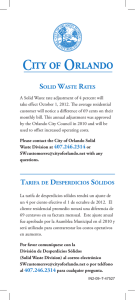

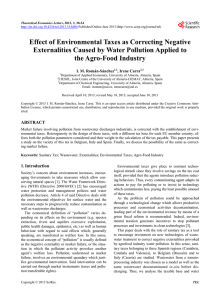
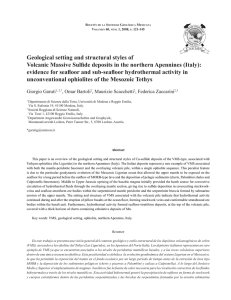
![Tríptico del curso [PDF 450KB]](http://s2.studylib.es/store/data/006258131_1-103c5de49e5ed6e7b549fd7206c4fb9a-300x300.png)
